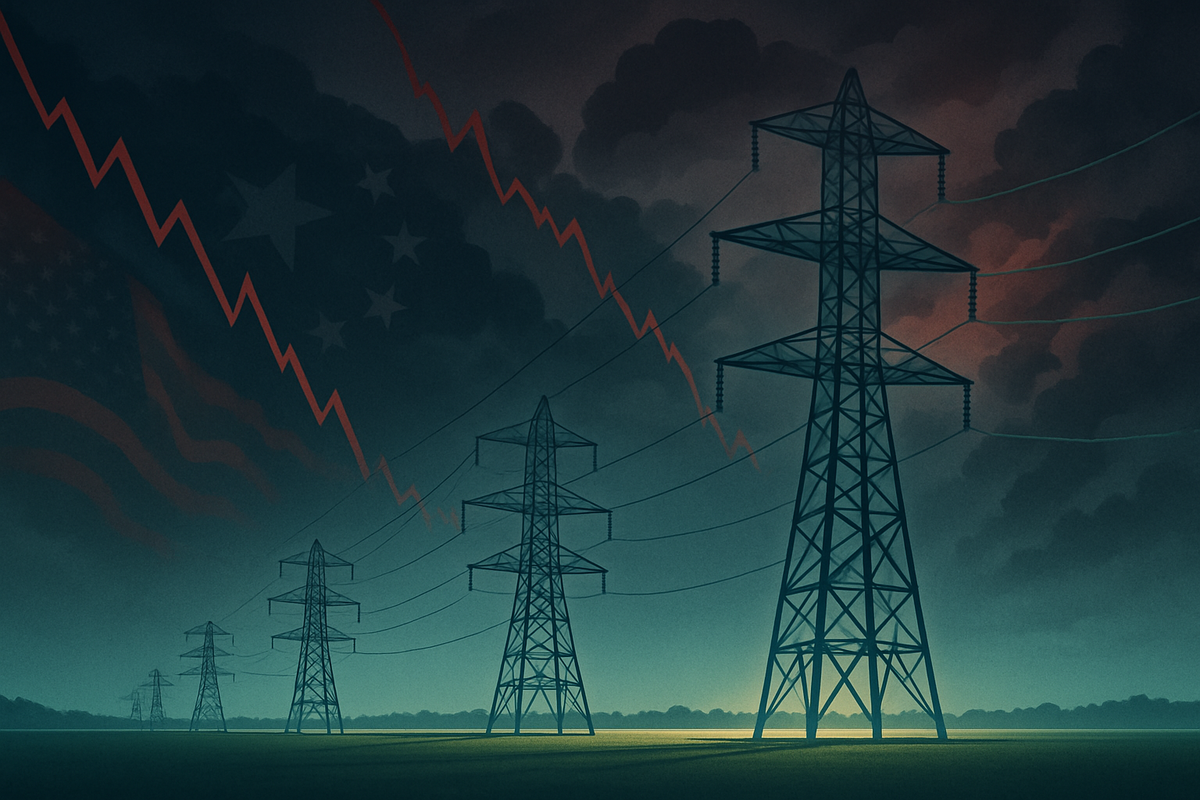
New York, NY – October 10, 2025 – Global financial markets were rocked today by a fresh wave of US-China tariff threats, sending major indices plummeting and igniting fears of a "Trade War 2.0." As investors scrambled for cover, the Utilities Sector, traditionally a safe haven during economic turbulence, demonstrated remarkable resilience, providing a crucial anchor of stability amidst the broader market sell-off. While the Dow Jones Industrial Average, S&P 500, and Nasdaq Composite suffered significant declines, the defensive nature of utility stocks helped them weather the storm with comparatively minor impacts, reinforcing their role as a vital component of a diversified portfolio in volatile times.
The renewed escalation in trade tensions, stemming from President Donald Trump's announcement of a "massive increase" in tariffs on Chinese imports and China's tightened export controls on rare earth minerals, triggered widespread anxiety. This geopolitical tremor, combined with existing concerns over AI stock valuations, rising bond yields, and an ongoing US government shutdown, created a perfect storm for a market correction. However, the consistent demand for essential services provided by utility companies—electricity, water, and gas—insulated the sector to a significant degree, offering a stark contrast to the sharp declines seen in more cyclically sensitive industries like technology and manufacturing.
Utilities Sector Holds Ground Against Market Onslaught
October 10, 2025, will be remembered as a day of sharp declines across Wall Street, with the broader market reacting swiftly and negatively to the re-ignition of US-China trade hostilities. The Dow Jones Industrial Average dropped by 1.05% to 45,873.63, the S&P 500 fell by 0.8%, and the tech-heavy Nasdaq Composite slid by nearly 2%. At one point, the Dow had plummeted over 900 points, and the S&P 500 was on track for its steepest single-day loss since April, signaling a profound shift from months of relative calm. This widespread risk aversion led investors to seek safety, driving up demand for traditional haven assets like Treasuries and gold.
In stark contrast to the market's dramatic downturn, the Utilities Sector exhibited commendable stability, largely fulfilling its role as a defensive investment. While precise real-time figures for the sector's exact movement on this specific day are still being compiled, several indicators and observations confirm its relative strength. The Utilities Select Sector SPDR Fund (NYSEARCA: XLU), a key ETF tracking the sector, has a beta of 0.54, indicating significantly lower volatility compared to the broader market. This inherent characteristic, driven by the inelastic demand for utility services, provided a buffer against the prevailing negative sentiment.
Leading up to today's events, the Utilities Sector had already demonstrated robust performance, with the XLU up over 20% year-to-date, outperforming the S&P 500's 14.5% gain over the same period. This strong underlying momentum, coupled with its defensive attributes, positioned the sector well to absorb the shock of the tariff threats. Investment analyses on October 10, 2025, continued to highlight ETFs like XLU and Vanguard Utilities ETF (NYSEARCA: VPU) as strategic defensive plays, particularly in anticipation of potential "AI Bubble Bursts" or amidst escalating trade and policy uncertainties. This proactive recognition of the sector's protective qualities by market analysts underscored its value in the current tumultuous environment.
The timeline of events leading to this market reaction began with President Trump's declaration of increased tariffs, citing China's restrictions on rare earth exports – critical components for high-tech industries. This move was quickly met with retaliatory rhetoric and actions from China, including an antitrust investigation into Qualcomm (NASDAQ: QCOM), further exacerbating fears of a full-blown trade war. Key players involved include the US and Chinese governments, global trade organizations, and multinational corporations heavily reliant on international supply chains. Initial market reactions were characterized by a rapid flight from risk, particularly from growth stocks and those with significant exposure to US-China trade. The Utilities Sector, however, stood out by largely resisting this flight, demonstrating its perceived insulation from direct trade war impacts.
Companies Navigate Tariff Headwinds and Seek Stability
The renewed US-China tariff threats, while broadly impacting the market, introduce a nuanced set of challenges and opportunities for individual utility companies. While the sector as a whole benefits from its defensive characteristics, specific firms face varying degrees of exposure to increased input costs and supply chain disruptions, particularly those heavily invested in renewable energy infrastructure reliant on imported components.
Companies aggressively pursuing large-scale solar and battery storage projects are among those most vulnerable to the escalating trade tensions. Tariffs on Chinese solar cells, battery energy storage system (BESS) components (such as lithium, cobalt, and graphite), and other electrical equipment are expected to drive up costs and potentially extend procurement lead times. Dominion Energy (NYSE: D), for instance, had previously reported that project-related tariff costs could reach approximately $500 million if current tariff policies persisted through late 2026, indicating significant exposure to imported materials. Its stock performance leading up to October 9, 2025, showed a slight decline, suggesting investor apprehension regarding its capital-intensive transition to net-zero emissions. Utilities with less diversified revenue streams or those with strained regulatory relationships may also struggle to pass on these increased costs to consumers, further compressing margins.
Conversely, utilities with strong domestic supply chains, diversified business models, and robust financial health are better positioned to weather the storm. NextEra Energy (NYSE: NEE), a major player with both a regulated utility arm (Florida Power & Light, FPL) and a substantial renewable energy segment (NextEra Energy Resources), has indicated that its tariff impacts are "modest and manageable," estimating only a 2-3% exposure on its considerable capital plan, largely due to a majority of material-based capital expenditures being sourced domestically. The stable and predictable revenue from its FPL segment, benefiting from Florida's growing population, further bolsters its resilience. Similarly, Xcel Energy (NASDAQ: XEL) and FirstEnergy (NYSE: FE) have also reported relatively low tariff exposures, estimated at 2-3% and less than 0.2% of their respective capital programs, thanks to proactive supply chain management and domestic sourcing.
Other companies like Entergy (NYSE: ETR) and PPL Corporation (NYSE: PPL) are actively working on alternative supply sourcing strategies and appear well-positioned to manage trade policy impacts. PG&E Corporation (NYSE: PCG), operating in California, benefits from aggressive state energy policies that necessitate substantial infrastructure investment, supported by a constructive regulatory environment that allows for cost recovery and above-average returns. Furthermore, pure-play water utilities such as Essential Utilities (NYSE: WTRG), with their focus on essential water, wastewater, and natural gas distribution, may have less direct exposure to the manufacturing supply chain disruptions impacting renewable energy components, offering another layer of stability in this volatile market. The ability of these companies to maintain constructive relationships with their state utility commissions will be paramount in securing timely rate adjustments to offset any unavoidable cost increases.
Wider Significance: A Stress Test for Resilience and Transition
The Utilities Sector's relative stability on October 10, 2025, amidst a tumultuous market sell-off driven by renewed US-China tariff threats, carries profound wider significance. It underscores the sector's enduring role as a defensive bulwark in times of economic uncertainty, but also highlights the complex challenges it faces in an era of rapid energy transition and escalating geopolitical risks. This event serves as a critical stress test, revealing both the inherent resilience and potential vulnerabilities within the industry.
This moment fits squarely within several broader industry trends. The sector is experiencing unprecedented load growth, fueled by the insatiable demand from artificial intelligence (AI) and data centers, coupled with widespread electrification in buildings and transportation. This surge necessitates massive investments in grid modernization and expansion, a process that becomes more expensive and challenging under the shadow of tariffs on critical components like transformers, solar cells, and battery materials. The ongoing decarbonization push, with utilities heavily investing in renewable generation, is particularly susceptible, as much of the global supply chain for these technologies traces back to China. The tariff threats, therefore, don't just impact current operations but threaten to slow down the pace and increase the cost of the essential clean energy transition.
The ripple effects of this scenario extend beyond the utility companies themselves. If tariff-induced cost increases are passed on, energy-intensive industries could face higher operational expenses, potentially impacting their competitiveness and supply chains. Renewable energy developers, partners to utilities in achieving decarbonization goals, could see project costs escalate and timelines extend. More broadly, the market's flight to the relative safety of utilities might divert capital from more growth-oriented, tariff-exposed sectors, influencing overall investment patterns. This shift could also accelerate efforts by governments and regulatory bodies to push for greater supply chain diversification and incentivized domestic manufacturing of critical utility components to reduce reliance on volatile international trade.
Historically, the Utilities Sector has consistently acted as a "safe haven" during economic downturns and periods of geopolitical tension, outperforming broader markets due to the inelastic demand for its essential services. This historical precedent helps explain its current resilience. Comparisons to past trade tensions, such as those seen in previous years, reveal similar patterns of increased costs for materials like steel and aluminum, impacting infrastructure projects. Wood Mackenzie's analysis of a "trade war" scenario suggested that long-term costs for utility-scale energy storage projects could increase significantly (12% to over 50%), and other energy technologies by 6% to 11%. Regulatory frameworks, which allow utilities to recover costs, provide a crucial buffer, but regulators now face the delicate balance of enabling essential investments while maintaining energy affordability for consumers, a challenge amplified by tariff-driven cost pressures.
What Comes Next: Navigating a New Era of Energy and Geopolitics
The Utilities Sector, having demonstrated its defensive strength on October 10, 2025, now stands at a critical juncture, facing a future shaped by the interplay of escalating trade tensions, technological advancements, and the relentless drive towards decarbonization. Both short-term adaptations and long-term strategic pivots will be essential for navigating this complex landscape.
In the short term, utilities will continue to grapple with the immediate consequences of increased tariffs. Higher procurement costs for steel, aluminum, solar panels, batteries, and transformers are inevitable, leading to potential project delays and budget overruns. Dominion Energy's (NYSE: D) Coastal Virginia Offshore Wind Project, for instance, has already seen its budget increase due to anticipated tariff costs, a scenario likely to be replicated across the industry. Supply chains, already strained, face further disruptions, potentially leading to equipment scarcity and increased inflationary pressures that could ultimately be passed on to consumers. Paradoxically, this very uncertainty solidifies the sector's appeal as a defensive investment, attracting capital from investors seeking stable, regulated earnings and consistent dividends amidst broader market volatility.
Looking further ahead, the long-term possibilities point towards a fundamental reshaping of the utility industry's operational model. A sustained period of trade friction will accelerate efforts to diversify supply chains, reducing reliance on single countries like China. This includes exploring new international suppliers, nearshoring, and a significant push for increased domestic production of critical materials and equipment. While this could lead to higher infrastructure costs initially, it promises greater supply chain resilience. The energy transition, though potentially slowed by expensive components, might also see a boost in localized renewable energy development and domestic green tech manufacturing. Crucially, the immense and growing energy demands from AI data centers will continue to act as a powerful long-term demand driver, necessitating substantial investment in new generation and grid modernization, providing a consistent revenue stream and justification for capital expenditures, even amidst tariff challenges.
To thrive in this environment, utilities must undertake significant strategic pivots. Proactive supply chain management is paramount, involving detailed assessments of tariff risks, identifying alternative suppliers, and upskilling procurement teams. Inventory optimization, including strategic stockpiling of critical assets, will become more common. Companies will prioritize domestic and diversified sourcing, engaging with regulatory bodies to ensure supportive policies that allow for prudent cost recovery. Continued investment in technological adoption, particularly AI and machine learning for predictive analytics and operational efficiencies, will be crucial. Furthermore, building flexibility into project timelines and equipment designs will allow utilities to adapt to potential delays and sourcing challenges.
Market opportunities will emerge from the necessity for domestic industry growth, particularly in rare earths, batteries, and clean energy components. The insatiable demand from AI data centers presents a significant and sustained growth opportunity. Regulated utilities, with their robust long-term sales contracts, may also find themselves with increased pricing power to pass on prudently incurred costs. However, significant challenges persist, including escalating costs, ongoing supply chain vulnerabilities, and potential risks to grid reliability if infrastructure upgrades are delayed. Broader economic headwinds from a protracted trade war, such as increased inflation or recessionary conditions, could reduce overall power consumption. The unpredictable nature of geopolitical volatility will make long-term planning inherently difficult, requiring constant vigilance and adaptability.
Potential scenarios and outcomes range from a protracted trade war leading to sustained high costs and significant supply chain restructuring, to a managed de-escalation with lingering impacts that still drive investment in domestic resilience. A strategic decoupling and regionalization scenario could see utilities focusing on regional sourcing blocs, fostering new trade partnerships and localized manufacturing hubs. Regardless, the overwhelming demand from AI data centers is likely to act as a strong counterweight to the negative impacts of tariffs, propelling robust investment in the sector. The path forward demands proactive and adaptive strategies focusing on supply chain diversification, technological innovation, and careful regulatory engagement to ensure resilience and continued service reliability amidst an unpredictable global trade environment.
Wrap-Up: A Resilient Sector in a Volatile World
Today's closing bell on October 10, 2025, delivered a clear message: while the broader market reels from renewed US-China tariff threats, the Utilities Sector remains a steadfast anchor of stability. This defensive sector largely provided the expected stability, demonstrating relative resilience against a broader market sell-off that saw major indices tumble. Its consistent demand for essential services, coupled with its regulated business model, shielded it from the direct impact felt by more cyclically sensitive industries.
Moving forward, investors should recognize the dual nature of this resilience. While utilities offer a crucial hedge against economic and geopolitical turbulence, they are not entirely immune. The escalating trade tensions introduce significant cost pressures on supply chains, particularly for the critical components needed for the ongoing clean energy transition and grid modernization. Companies with proactive supply chain management, diversified sourcing strategies, and strong regulatory relationships are best positioned to mitigate these challenges.
The lasting impact of this period will likely be a heightened focus on supply chain resilience and domestic manufacturing across the utility industry. What investors should watch for in the coming months includes how individual utility companies adapt their capital expenditure plans, their success in negotiating tariff costs with regulators, and the pace at which they diversify their sourcing away from potentially volatile international markets. The sector's ability to balance the imperative of decarbonization with the realities of increased costs and supply chain disruptions will define its trajectory in this new, more volatile global landscape.
This content is intended for informational purposes only and is not financial advice







